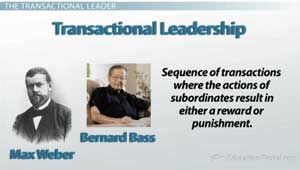The Transactional Leader
After you watch the video and know the material, click HERE for the quiz.
This lesson describes the characteristics of a transactional leader. Discover how a transactional leader depends on the concepts of actions and reactions to motivate, manage and guide employees to success.
Actions and Reactions
Sir Isaac Newton's third law of motion states that for every action, there is a reaction. This is quite true when you think about it. For example, when you smile at a stranger on the street, they, typically, will smile back; when you sneeze someone responds by saying bless you; pressing the gas pedal of your car causes you to accelerate; cheating on your spouse can end in a divorce; and coming in late to work repeatedly might just get you fired. The list goes on and on, and I'm sure many of you can think of things you have done and the consequences that resulted.
This action/reaction rule of life is what guides most of our daily behaviors. We wake up each day and shower so that we don't stink. We go to work so that we can pay our bills. We eat food and drink fluids so that we can continue to live. We exercise to stay healthy, spend time with our friends and family to maintain our relationships and go to sleep at night to ensure we can do it all over again tomorrow.
The Transactional Leader
 |
 |
Using their authority as a manager, the transactional leader gives orders to subordinates and expects that the reaction will be adherence to the commands. Those individuals who do conform to the requests of the transactional leader are rewarded and anyone who fails to is punished. The expectation that employees will follow the transactional leader's request is believed to start when a worker accepts the job at which time a standard is set, and the leader is given authority based on the chain of command.
 |
Since the leader is higher on the chain of command than the subordinate is, the employee is expected to follow the orders given by the leader. The transactional leader's power to direct subordinates comes from their formal authority and responsibility in the organization.
While this leadership approach might remind you of what it's like to live with your parents, it is really quite logical. To begin, it clearly defines the roles and responsibilities of both managers and their employees.
 |
 |
The transactional leader who uses passive management by exception will monitor the employee's performance closely and intervene only when an employee is not meeting the expectations, often resulting in a punishment. Conversely, the transactional leader who uses active management by exception will monitor employee performance closely, watch for slight deviations and quickly intervene to take corrective action to prevent further mistakes.
TaKesha the Transactional Leader
To better understand the transactional leader, let's take a look at the following example of how TaKesha, the transactional leader, manages her employees at Supa Sporting Goods, a local retail chain.
It's Monday morning, and TaKesha receives an email from her boss that informs her of a new product that will be arriving sometime today from the manufacturer. She also learns that the product will be offered exclusively at Supa Sporting Goods, and the manufacturer is expecting Supa to do what it takes to get the product off the shelves and into the hands of the customers as fast as possible. TaKesha knows she must communicate this information to her employees and come up with an action plan for how they will sell the new product to customers.
TaKesha has high aspirations for her employees because they learned from the moment they were hired that what TaKesha wants TaKesha gets. Since she is their manager and higher on the chain of command, the employees willingly do whatever it is that TaKesha asks, as long as it does not put them in harm's way. The employees understand their role in the organization is to follow the directions of TaKesha due to her formal authority and responsibility in the organization.
During the Tuesday morning meeting, TaKesha explains the new product to her employees and provides them with a detailed action plan for how they can go about selling the new product to Supa's customers. As a transactional leader, TaKesha is clear on her intentions of her employees to do everything in their power to sell the new item. To help motivate her staff, TaKesha informs them that whoever meets their individual sales goals will receive an extra day of paid vacation, but those who fail to meet their sales goals will be forced to cover the shift of those who earn the extra vacation day. TaKesha tells her employees that they are responsible for creating their own promotional activities necessary to make the sales. Any worker who fails to design an effective sales strategy will fail at meeting their sales goals and consequently will be held accountable for that failure. TaKesha practices a passive management by exception and informs her employees that she will be monitoring their performance on a weekly basis. Any staff member who does not meet their required sales quota will be asked to clean the store bathrooms that following week.
Lesson Summary
Let's review. Much like Newton's third law of motion, transactional leadership runs under the premise of actions and reactions. The transactional leader views management as a sequence of transactions where the actions of subordinates result in either a reward or punishment. Those individuals who do conform to the requests of the transactional leader are rewarded and anyone who does not is punished. The authority of the transactional leader is based on the chain of command where the subordinates are expected to follow the directions of those who hold higher-level positions in the organization.
The benefits of transactional leadership include:
- Clearly defined roles and responsibilities
- Healthy motivation to work towards organizational goals
- A high level of employee responsibility and accountability
To monitor this accountability, the transactional leader uses management by exception, which can be either passive or active. The transactional leader who uses passive management by exception will monitor employee performance closely and intervene only when an employee is not meeting the expectation, often resulting in a punishment. Conversely, the transactional leader who uses an active management by exception will monitor employee performance closely, watch for slight deviations and quickly intervene to take corrective action to prevent further mistakes.